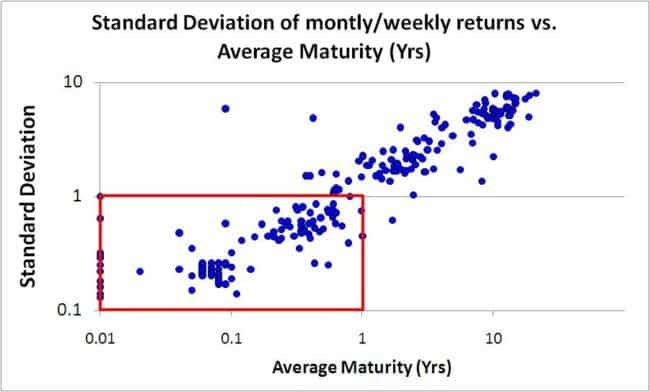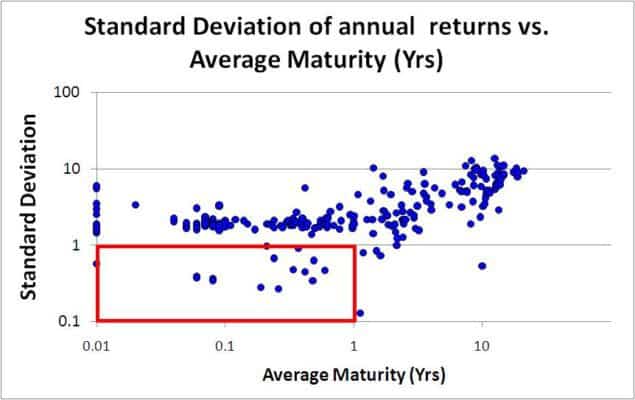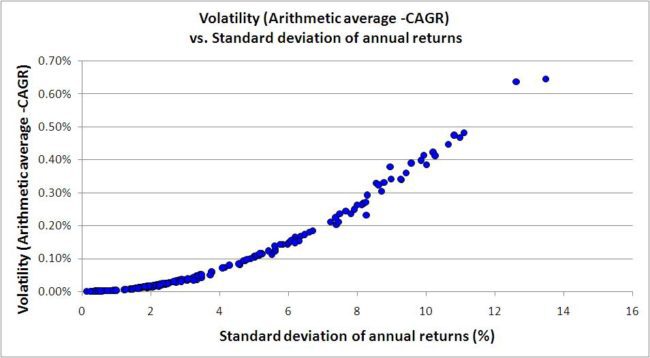Last Updated on September 11, 2021 at 6:10 pm
We choose a type of instrument almost solely based on the kind of returns that it can yield. Thus, our expectation is governed by past history. While there is nothing wrong with this, past returns can vary quite a bit, and depends on the period chosen for evaluation.
While it is a good idea to base expectations on past history, only must also understand and appreciate the uncertainty associated with the expectation. The uncertainty will depend on the type of instrument and the duration of intended investment.
Regular readers know that I am a fan of the standard deviation and would recall that it can be used to select mutual fund categories suitable for financial goals.
The standard deviation listed by mutual fund portals like Value Research, Money Control, Morning Star etc. are typically based on monthly/weekly returns. While they can be used to represent the expected volatility associated with an instrument, they are not an accurate representation of the volatility or the uncertainty associated with past returns and therefore with future returns.
Join 32,000+ readers and get free money management solutions delivered to your inbox! Subscribe to get posts via email! (Link takes you to our email sign-up form)
🔥Want to create a complete financial plan? Learn goal-based investing? Exclusive access to our DIY tools? Increase your income with your skills? Use this link to enjoy massive discounts on our robo-advisory tool & courses! 🔥
Why not,
1) consider past annual returns of an instrument,
2) calculate the arithmetic average (not CAGR which is the geometric average),
3) calculate the associated standard deviation of the annual return,
4) Assume the arithmetic average ~ the expected future return from the instrument, plus or minus the standard deviation.
An example might help:
Let us consider the annual returns of Kotak Liquid Fund (source Value Research online)
The arithmetic mean or average = 7.33%
The standard deviation is 1.91%
So if I wanted to invest in Kotak Liquid, I will expect a return of about 7% give or take 2% (1.91 is approximated to 2%)
That is I will expect a return from 7% -2 % = 5% to 7%+2% = 9%
Calculating standard deviation this way, gives me a better idea of the range over which returns have fluctuated in the past. Although past performance may not repeat in the future, I have a foot hold with respect to expectations.
According to VR online, the fund has a standard deviation of 0.26%. Since this is calculated with monthly/weekly returns, it does not help me much since I am interested in annual returns.
The value of 0.26% when compared with corresponding data of other debt fund categories gives me an idea of relative volatility.
The value of 1.91% calculated with annual returns gives me an idea of absolute volatility.
This is how the standard deviation calculated with monthly/weekly returns evolves with respect to the average maturity of all debt fund portfolios.
Notice that region inside the red rectangle (< 1% standard deviation and < 1 year maturity) is heavily populated. These are liquid funds, ultra-short term funds, short-term income and gilt funds.
If the standard deviation of annual returns is used instead (below), notice that most of the points are outside the red rectangle.
Thus, if we use the standard deviation of annual returns, we find that even liquid funds are quite volatile. That is their annual returns can vary by a significant amount.
Higher the average maturity, higher the standard deviation in both cases.
Amusingly the 10 year CAGR (geometric average) is 7.31%. Not very different from the arithmetic average.
The difference between the two averages is another measure of relative volatility. The difference will be zero for a fixed deposit. Higher the difference, higher the volatility.
When the difference between the arithmetic average and the CAGR is plotted versus the average maturity in years of all debt fund portfolios, this is how it looks like.
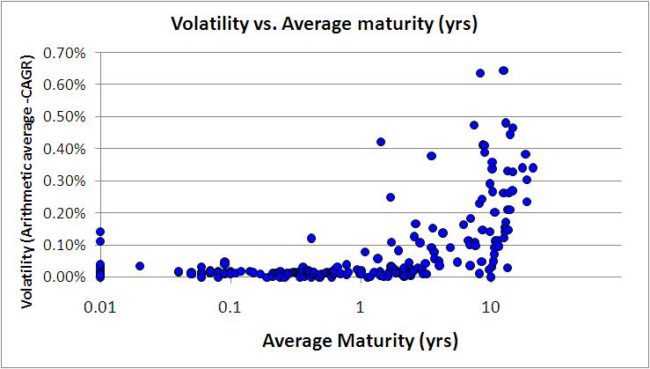
Notice that the difference between the arithmetic average and CAGR is negligibly small for average maturity periods less than 1 year. Beyond that duration, the difference rapidly increases. However, even for the longest maturity periods (long term gilt funds), the difference is less than 1%.
Therefore, the simpler arithmetic average of annual returns is a pretty good alternative for the CAGR and could be set as the average return one can expect from a debt mutual fund.
The same will not be true for equity funds due to their much high volatility. We will consider these in another post.
The relative volatility (difference between arithmetic mean and CAGR) shares an interesting relationship with the absolute volatility (standard deviation of the annual return).
Notice how smoothly the curve evolves for all debt mutual funds. The evolution is faster than a straight line. Thus, the difference between the arithmetic average of returns and CAGR becomes more prominent at higher standard deviations.
Finally, a look at the CAGR of all debt mutual funds 10 years or older. This would give us an idea while planning for goals.
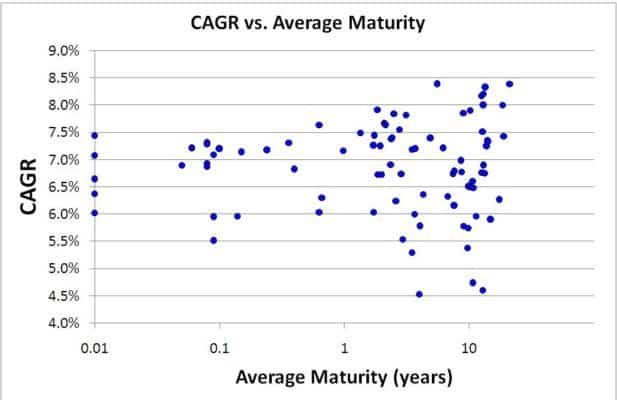
That does not paint a pretty picture at all!. The long-term return of funds with high average maturity (eg. long-term gilt funds) is comparable to funds with low average maturity (eg. ultra-short funds, short-term funds or even liquid funds)!!
Thus, if one wishes to invest in funds with high average maturity, they should actively manage the fund. That is, they should shift gains (to equity, for example) when interest rates drop, or invest more when the interest rates rise. A ‘buy and hold’ strategy with such funds may not be beneficial.

Use our Robo-advisory Tool to create a complete financial plan! ⇐More than 3,000 investors and advisors use this! Use the discount code: robo25 for a 20% discount. Plan your retirement (early, normal, before, and after), as well as non-recurring financial goals (such as child education) and recurring financial goals (like holidays and appliance purchases). The tool would help anyone aged 18 to 80 plan for their retirement, as well as six other non-recurring financial goals and four recurring financial goals, with a detailed cash flow summary.
🔥You can also avail massive discounts on our courses and the freefincal investor circle! 🔥& join our community of 8000+ users!
Track your mutual funds and stock investments with this Google Sheet!
We also publish monthly equity mutual funds, debt and hybrid mutual funds, index funds, and ETF screeners, as well as momentum and low-volatility stock screeners.
You can follow our articles on Google News

We have over 1,000 videos on YouTube!

Join our WhatsApp Channel



- Do you have a comment about the above article? Reach out to us on Twitter: @freefincal or @pattufreefincal
- Have a question? Subscribe to our newsletter using the form below.
- Hit 'reply' to any email from us! We do not offer personalised investment advice. We can write a detailed article without mentioning your name if you have a generic question.
Join 32,000+ readers and get free money management solutions delivered to your inbox! Subscribe to get posts via email! (Link takes you to our email sign-up form)
About The Author
 Dr M. Pattabiraman (PhD) is the founder, managing editor and primary author of freefincal. He is an associate professor at the Indian Institute of Technology, Madras. He has over 13 years of experience publishing news analysis, research and financial product development. Connect with him via Twitter(X), LinkedIn, or YouTube. Pattabiraman has co-authored three print books: (1) You can be rich too with goal-based investing (CNBC TV18) for DIY investors. (2) Gamechanger for young earners. (3) Chinchu Gets a Superpower! for kids. He has also written seven other free e-books on various money management topics. He is a patron and co-founder of “Fee-only India,” an organisation promoting unbiased, commission-free, AUM-independent investment advice.
Dr M. Pattabiraman (PhD) is the founder, managing editor and primary author of freefincal. He is an associate professor at the Indian Institute of Technology, Madras. He has over 13 years of experience publishing news analysis, research and financial product development. Connect with him via Twitter(X), LinkedIn, or YouTube. Pattabiraman has co-authored three print books: (1) You can be rich too with goal-based investing (CNBC TV18) for DIY investors. (2) Gamechanger for young earners. (3) Chinchu Gets a Superpower! for kids. He has also written seven other free e-books on various money management topics. He is a patron and co-founder of “Fee-only India,” an organisation promoting unbiased, commission-free, AUM-independent investment advice.Our flagship course! Learn to manage your portfolio like a pro to achieve your goals regardless of market conditions! ⇐ More than 3,500 investors and advisors are part of our exclusive community! Get clarity on how to plan for your goals and achieve the necessary corpus no matter the market condition!! Watch the first lecture for free! One-time payment! No recurring fees! Life-long access to videos! Reduce fear, uncertainty and doubt while investing! Learn how to plan for your goals before and after retirement with confidence.
Increase your income by getting people to pay for your skills! ⇐ More than 800 salaried employees, entrepreneurs and financial advisors are part of our exclusive community! Learn how to get people to pay for your skills! Whether you are a professional or small business owner seeking more clients through online visibility, or a salaried individual looking for a side income or passive income, we will show you how to achieve this by showcasing your skills and building a community that trusts and pays you. (watch 1st lecture for free). One-time payment! No recurring fees! Life-long access to videos!
Our book for kids: “Chinchu Gets a Superpower!” is now available!


Must-read book even for adults! This is something that every parent should teach their kids right from their young age. The importance of money management and decision making based on their wants and needs. Very nicely written in simple terms. - Arun.Buy the book: Chinchu gets a superpower for your child!
How to profit from content writing: Our new ebook is for those interested in getting a side income via content writing. It is available at a 50% discount for Rs. 500 only!
Do you want to check if the market is overvalued or undervalued? Use our market valuation tool (it will work with any index!), or get the Tactical Buy/Sell timing tool!
We publish monthly mutual fund screeners and momentum, low-volatility stock screeners.
About freefincal & its content policy. Freefincal is a News Media organisation dedicated to providing original analysis, reports, reviews and insights on mutual funds, stocks, investing, retirement and personal finance developments. We do so without conflict of interest and bias. Follow us on Google News. Freefincal serves more than three million readers a year (5 million page views) with articles based only on factual information and detailed analysis by its authors. All statements made will be verified with credible and knowledgeable sources before publication. Freefincal does not publish paid articles, promotions, PR, satire or opinions without data. All opinions will be inferences backed by verifiable, reproducible evidence/data. Contact Information: To get in touch, please use our contact form. (Sponsored posts or paid collaborations will not be entertained.)
Connect with us on social media
- Twitter @freefincal
- Subscribe to our YouTube Videos
- Posts feed via Feedburner.
Our publications
You Can Be Rich Too with Goal-Based Investing
 Published by CNBC TV18, this book is designed to help you ask the right questions and find the correct answers. Additionally, it comes with nine online calculators, allowing you to create custom solutions tailored to your lifestyle. Get it now.
Published by CNBC TV18, this book is designed to help you ask the right questions and find the correct answers. Additionally, it comes with nine online calculators, allowing you to create custom solutions tailored to your lifestyle. Get it now.Gamechanger: Forget Startups, Join Corporate & Still Live the Rich Life You Want
 This book is designed for young earners to get their basics right from the start! It will also help you travel to exotic places at a low cost! Get it or gift it to a young earner.
This book is designed for young earners to get their basics right from the start! It will also help you travel to exotic places at a low cost! Get it or gift it to a young earner.Your Ultimate Guide to Travel
 This is an in-depth exploration of vacation planning, including finding affordable flights, budget accommodations, and practical travel tips. It also examines the benefits of travelling slowly, both financially and psychologically, with links to relevant web pages and guidance at every step. Get the PDF for Rs 300 (instant download)
This is an in-depth exploration of vacation planning, including finding affordable flights, budget accommodations, and practical travel tips. It also examines the benefits of travelling slowly, both financially and psychologically, with links to relevant web pages and guidance at every step. Get the PDF for Rs 300 (instant download)
